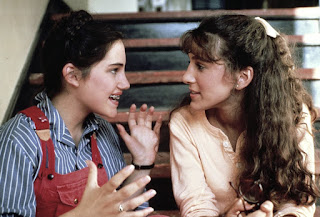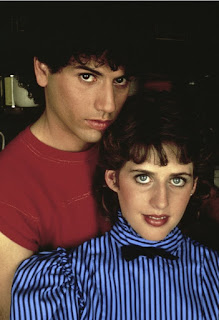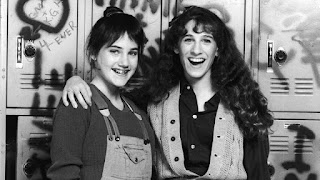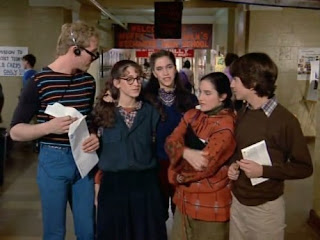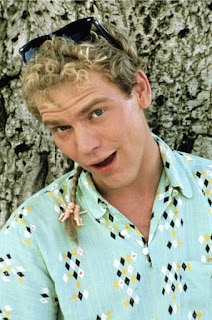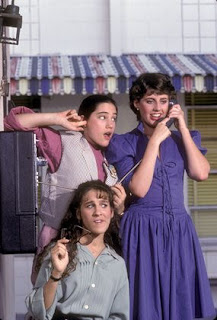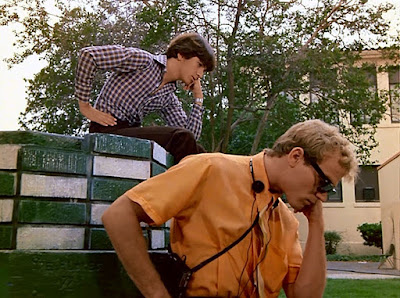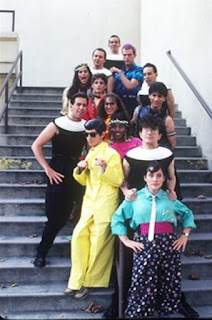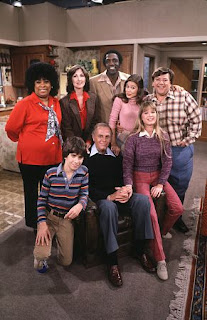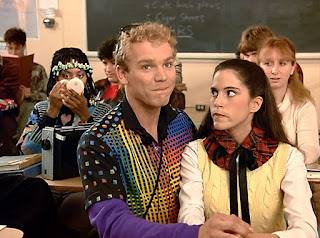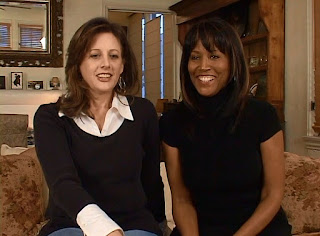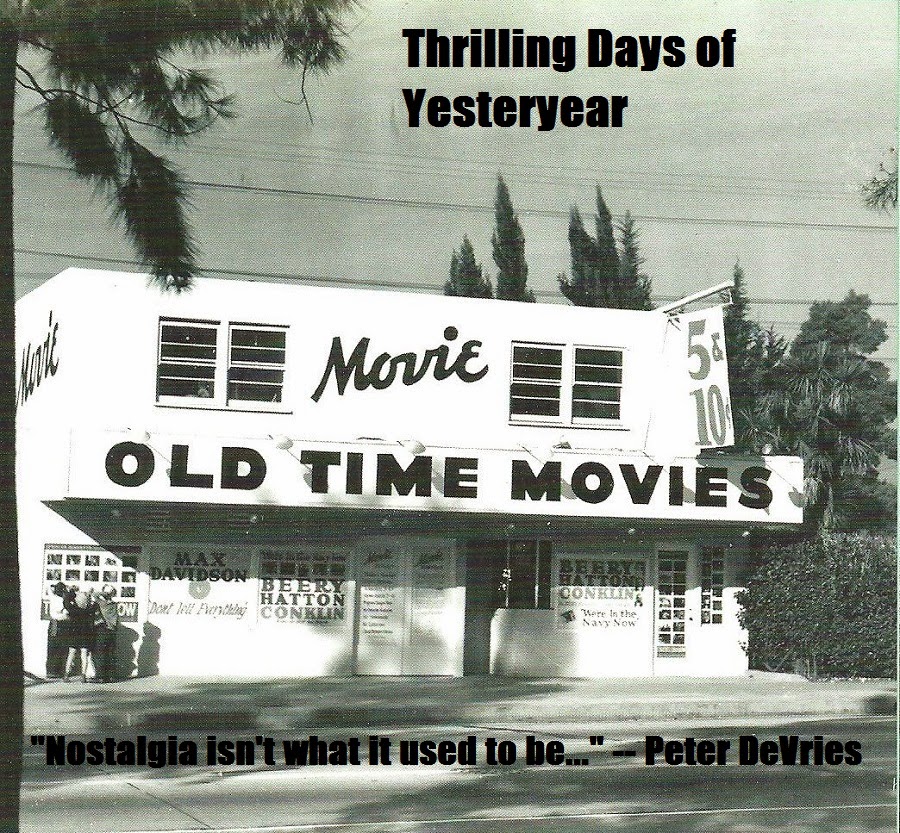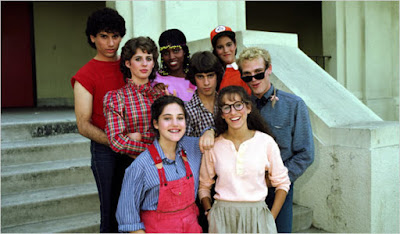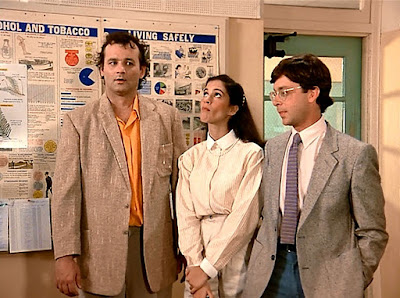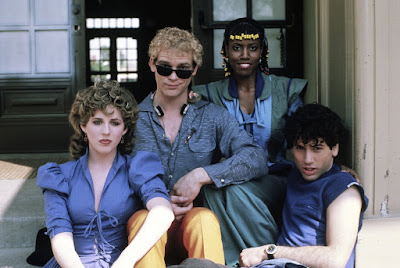Thrilling Days of
Yesteryear’s weekly dissection (well…I
try
to make it weekly) of MGM’s
Crime Does
Not Pay series continues with
Hit-and-Run Driver (1935)—an
interesting entry in that it was penned by two scribes whose names might be
familiar to fans of Abbott & Costello movies: Robert Lees and Frederic I.
Rinaldo (billed in the credits as Fred Rinaldo). This screenwriting duo, after serving an apprenticeship
at MGM penning Pete Smith and Robert Benchley shorts, was responsible for
several of Bud and Lou’s best feature film comedies:
Hold That Ghost (1941),
The
Wistful Widow of Wagon Gap (1947), and
TDOY
Halloween favorite
Abbott & Costello
Meet Frankenstein (1948). (Lees
& Rinaldo also wrote the screenplay for Olsen & Johnson’s
Crazy House [1943], for which we are
most grateful, and 1941’s
The Invisible Woman…for which we are
not.) Both men were sadly felled by the
blacklist in the early 1950s, and while Rinaldo seems to have hung up his gun
after the Martin & Lewis romp
Jumping
Jacks (1952), Lees continued to write (using “J.E. Selby” as his alias) for
such TV series as
Rawhide,
Lassie, and
Daktari.
But let us now visit with the “MGM Reporter” (William
Tannen)—a man later identified as…Jim.
JIM: Ladies and gentlemen, as
the MGM Reporter it has been my job to bring to you accounts of criminal cases
proving indisputably that crime does not
pay…today my message is more
urgent than ever…for a new menace is
sweeping the country, causing more deaths than America suffered during the
entire World War…
You can tell Jim is serious because he’s wearing his squinty
expression.
JIM: Thirty-seven thousand were
killed and approximately one million injured last year alone…from all over the
country come reports of violent deaths, horrible mutilation…no one is safe from
this new public enemy…who is he? He may
be your neighbor…he may be that person in the seat next to you…
Boy, wouldn’t it be weird if the guy seated next to you was also your neighbor?
JIM: He is the driver of any one
of America's 25 million automobiles…I would like Captain James of the Kent
County Traffic Division to tell you just how the police deal with this
situation….
JAMES: Thanks, Jim…sit down…
“You make me nervous.”
MGM is just darn lucky that this short came out before RKO started its
Saint movie franchise with
The Saint in New York (1938), because
“Captain James” is easily recognizable as actor Jonathan Hale—who played
“Inspector Fernack” in five entries of that series with Louis Hayward and then
George Sanders. (And if this short had
been released in 1938, MGM would have really been red-faced—that was the year
Hale debuted with his most famous film role, that of J.C. Dithers in Columbia’s
Blondie series.)
JAMES: To combat this type of
killer, we've developed a highly
scientific method of detection…so efficient is this method that few
hit-and-run drivers escape ultimate
conviction…as an illustration, take the case that happened last June, along
the Columbia Turnpike…
And with that, we are whisked into the passenger seat of a
car that is traveling a little too fast down a dark country road for my
tastes. The person behind the wheel
seems a little inebriated, and he’s unable to stop when a young couple appear
out of nowhere to cross the road…
The driver of the vehicle crashes into the couple, spraying
windshield glass all over the soft shoulder.
He gets out to examine the situation, and the young man (later
identified as David Benedict), lying bloody on the ground, summons up the
strength to call out “Help…” The
responsible party
should do the right
thing and move Heaven and Earth to get his victims to the hospital for proper medical
attention with all deliberate speed. But
because
The Voice is on in fifteen minutes—and he forgot to set the
DVR—the unknown driver hops back into his jalopy and heads back the way he
came. Rat bastard.
At 2:15am, a call comes into the Kent County police station
and it’s answered by the desk sergeant (William Gould)—someone is reporting the
accident involving young David and his girlfriend, Eleanor Spears. Quickly, Kent County’s finest are dispatched
to the scene of the crime—Detective John “Sandy” Sanderson (Morgan Wallace),
Detective Al Squires (Carl Stockdale), and a third detective named Lee (who
goes unidentified at the [always reliable] IMDb) begin their examination of the
crime scene, which involves…
…a tire track, for one.
Captain James explains via voiceover that a plaster impression of the
track—a moulage—needs to be taken in order to show “the structure and depth of
the markings.” Sanderson also begins to
collect every available piece of the shattered windshield, which we will later
see he’s assembled as one might put together a jigsaw puzzle. The detectives are initially discouraged that
the car involved in the incident was headed toward New York—which means
locating the vehicle will require a full-length feature film. But an examination of the “oil drippings”
reveals that that the car headed in the opposite direction, so we can have this
baby wrapped up in twenty minutes. (As
for the victims…well, they are so badly hurt it’s impossible to question either
of them.)
SANDERSON: As you can see from
the map, Chief, the turnpike runs through Hanover…Woodland…Wells…and
Oceanside…then comes to a dead end…
“You can also see why I have my eye on that sweet piece of
property in Wells…I plan to open up a bar when I’m retired and on my pension.”
SANDERSON: So if the car turned
around…and went in that direction…at that time of night…the driver must still be in that locality…now we have no
known witnesses to the crime…but there are a couple of pretty definite leads to work on…
They’ll start with the moulage of the tire track found at
the scene of the crime. “We’ll know
it…if we find it,” declares Sanderson.
Sanderson has already started to work on that “jigsaw puzzle” I alluded
to earlier:
The plan is to canvass the local garages and see if anyone
brought in a smashed-up automobile. One
garage, where a mechanic named “Walter” works (the actor is unidentified at the
IMDb), informs Sanderson that someone did bring in such a vehicle—both the
windshield and headlights were smashed.
“She must have hit something awfully hard,” observes Walter. (No biggie, dude—just a couple of stray
pedestrians.) There’s just one teensy
problem…
SANDERSON: Whad’ja do with the glass that was left from the windshield?
WALTER: There wasn’t none…she
was brought in clean as a whistle…
SQUIRES: Listen, Sandy…this
ain’t the car we’re lookin’ for either…
That’s because none of the tires are on the car match the
moulage impression, unfortunately—and Walter swears he didn’t change any
tires. This could be a challenge! But Sanderson gets the address of the car’s
owner from helpful Walter (I guess there are no issues of confidentiality where
auto repair is concerned)—it belongs to a young student named George Lambert
(George Walcott), and he’s staying in town for the summer at the Beach Ridge
Hotel. Sanderson is going to have a chat
with young Lambert, and he instructs Squires to go over the car “with a
fine-tooth comb” since he’s noticed slivers of glass on the running board. (He really
wants to finish that puzzle.)
George is hauled into the police station and questioned by
Sanderson and his fellow detectives.
Here’s his story: he spent the evening of the accident with his
girlfriend at a fine establishment known as “Frankie’s Roadside Café,” arriving
there at 11:45pm. At 1:30, Lambert was
ready to do some major pub-crawling and planned to head to “The Old Orchard
Inn”—but his main squeeze wanted to go home.
The two of them had a quarrel about their plans for the rest of the evening
(although by that time it was technically morning), and that resulted in her
leaving with some of their mutual friends while George elected to stay at
Frankie’s. (Lambert had the keys to his
car with him…so no one else could have driven it.)
LAMBERT: …I guess I must have
been a little drunk,
because…uh…Frankie, the proprietor—he’s a friend of mine—steered me to a table
and talked me into having a cup of coffee with him…
As you can see from the above screen grab, Frankie is
portrayed by portly character veteran Cy Kendall…which should be an immediate
tip-off that George’s story is not quite kosher. (You know Cy from the serials
The Green Hornet [1940] and
Jungle Queen [1945], featured on
TDOY’s Serial Saturdays.) George continues telling the gendarmes that
the two of them heard a noise outside the roadhouse, and when they went outside
to investigate George found that his car had been hit by someone who then sped
off into the night.
LAMBERT: Look what that rat did to my car…
FRANKIE: Yeah…some drunken
fool…there ought to be a law to deal
with people like that…
I’m pretty sure there is, Frank. Oscar, Frankie’s lackey (also unidentified at
the IMDb), arrives in time to see his boss and George surveying the damage…and
Frankie instructs his man to get a broom and sweep up the glass. Thus endeth the flashback.
SANDERSON: …and what time did
you leave?
LAMBERT: Well, I hung around
till closing time—about 2:30…then I went straight home…
SANDERSON: To the hotel…?
LAMBERT (nodding): Yes…
SANDERSON: Then you didn’t go
out along the Columbia Turnpike at any
time…
LAMBERT: No…
SANDERSON (leaning forward in
his chair): You’re sure?
This last bit made me laugh out loud—and I don’t know if it
was Morgan Wallace’s delivery or the feeling that I got that the character was
getting ready to say: “Listen, you little punk—I know in my donut-filled gut
that you’re guilty, and I’m gonna get a confession if it takes me the rest of
the day! Al, get the phone book!” (I’ll bet that phone book still has an
impression of my father’s head on it.)
“Let me ask you a question,” Lambert inquires cheekily. “Did you get the man who backed into
me?” He’s awfully smug for a person of
interest, but Sanderson tells him the usual don’t-leave-town-we-may-have-further-questions-yadda-yadda-yadda. “I hope you get that guy,” are George’s
parting words as he bids Detective Flatfoot a fond adieu. If this were an episode of Law
and Order, the Lambert character would be merely a red herring leading
us to another suspect…but since we’re at the halfway point of this two-reeler,
it looks like George Lambert is our man—so how to prove it?
JAMES: It looked as though we
had the wrong car…it had different
tires and there were three makes of
automobiles equipped with similar lenses…we had no witnesses…and our only subject had a perfect alibi…but the
department never rested…
“We executed round-the-clock use of the truncheon until we
got a confession out of that little
weasel.” No, I’m just kidding you
(maybe). The break in the case is
revealed when the gendarmes bring Georgie in for more questioning.
JAMES (showing Lambert a
photograph): Did you ever see those two persons before?
“Why, yes…I believe it’s from
Gidget Gets a Cold Sore. I
saw it the other night with my preten…er, my girlfriend.”
JAMES: The boy is David
Benedict…and the girl is his fiancée, Eleanor Spears…perhaps you’ll recognize
them from this…
James shows Lambert a photo that the audience does not
see—but the implication is that it’s a candid of the two lovers after they were
plowed down in the accident.
JAMES: And it’s too bad that
driver didn’t think about the law…he
might have given those two youngsters a break by rushing them to the hospital…
LAMBERT: I quite agree with you,
Captain—but after all…what’s that got to do with me?
Oh…puh-lenty, my young homicidal motorist. You see, after an extensive investigation the
ever-resourceful Al learned that George’s automobile was “washed and cleaned”
before it was brought in. He located a
piece of glass in the vehicle, one that would appear to have magnification
properties…
…it’s a piece from David Benedict’s broken eyeglasses! An oculist confirmed the prescription for
Detective Sanderson.
SANDERSON: David Benedict, Lambert…the boy who’s dying in the county hospital…
JAMES: And that piece from his
glasses was found on the running board
of your car!
LAMBERT: You can’t make me
believe that! You’re just trying to scare me into saying something!
The noose begins to tighten around George’s lily-white
neck. Sanderson went back to check on
the kid’s story at Frankie’s Roadside Café…and found a piece of glass in the
grass where Frankie alleged Lambert’s car was parked. That would seem to square his alibi…except
for the part where that same shard fits so neatly in Sandy’s glass jigsaw
puzzle!
There’s a somewhat embarrassing scene with one of
Sanderson’s detectives and Oscar the handyman where the cop extracts a
confession from Oz that the tires on Lambert’s car were changed because he sold
the discarded tires (they were dumped around the back of the garage) to a
relative who owns a junkyard. What makes
this so uncomfortable is that Oscar is stereotyped to the nth degree (“You ask
questions so fast I don’t know who I am or where I is no more”), with the
detective threatening to throw him in the pokey if he doesn’t talk. (Nowadays the cop would have just tased his
ass and then claimed he was in fear for his life…if Oscar were lucky.)
 |
| Mantan Moreland would have made this funny. |
The tire in question is rolled out to George along with the
moulage, with Sanderson drily observing “They match.” It’s all purely circumstantial, of course,
but a couple of hours with Sanderson in the interrogation room and Lambert will
start babbling he
was on the grassy
knoll that day in Dallas. This won’t be
necessary: the phone rings in James’ office next door, and it’s a Dr. Flynn
(Howard C. Hickman) on the phone.
FLYNN: …the boy has regained
consciousness…but I advise you to hurry,
Captain…
JAMES: Fine—we’ll be right over!
James completes the call and re-enters the room with George
and the other detectives. “Come on,
Lambert…we’re going down to the hospital to have a talk with David Benedict.”
“What for?” asks Lambert.
“The state may have a witness”
is James’ icy reply. (Stay strong,
Georgie!)
Spoiler warning: he doesn’t stay strong. Arriving at the hospital with Lambert and
Sanderson, James learns from the doctor that he tried to get hold of James
before he left the station—Benedict has suffered a relapse, and will have to
undergo an operation. “Any chance?”
Sandy asks Flynn. The way Flynn shakes
his head as if to say “You’d be better off placing a bet on the Grim Reaper”
made me titter. When Flynn is asked if
Benedict’s fiancée can provide an identification, the detectives are told that
the accident rendered her blind and paralyzed.
“Had those people been rushed to a hospital immediately,” Flynn scolds,
“both would
still have their lives
before them.” (The Supreme Being would appear
to have a whoopee-cushion-sense of humor.)
Director Edward L. Cahn nicely handles a sequence in which
George Lambert is forced to watch his victim’s operation—the little anesthesia
balloon inflates and deflates throughout…and then stops inflating…
…signaling to the audience that David has drawn his rations
and can now have a chinwag with the person in charge of the universe as to why
he blinded and paralyzed his girlfriend, the sick f**k. Lambert, witnessing Benedict’s death on the
operating table, confesses in
Perry Mason-like hysterics that,
yes, he was guilty of the hit-and-run and he’s very, very sorry and he won’t
ever do it again, promise, cross my heart. “I…I…know it
was a horrible mistake but…please…can’t you see
my side of it?” he wails.
That will be up to Judge Hanging, played by another character vet, Sam
Flint. (His name isn’t really
“Hanging”—I make leetle joke.)
JUDGE: George Lambert…before
passing sentence upon you, the court has taken into full account your side of
this case…and I regret to say I can find no
extenuating circumstances…
Well, so much for that.
The judge continues: “Now you say
you are sorry, but your penitence cannot bring life to David Benedict or
eyesight to Eleanor Spears...the magnitude of your crime and the havoc caused
by your criminal neglect leave me no alternative…George Lambert, this court
sentences you…”
“…to a dose of syphilis.”
Okay, I’m just jinkin’ ya again.
The judge gives George twenty years…but in the words of Captain James,
“In his heart he knew he had committed murder, and the indelible memory of what
he'd done to that boy and girl will remain with him for the rest of his life.”
And on that upbeat note, I’ll remind you to return next week
when our
Crime Does Not Pay
presentation will be
The Perfect Set-Up
(1936). (S.Z…stay out of mischief!) G’bye now!
